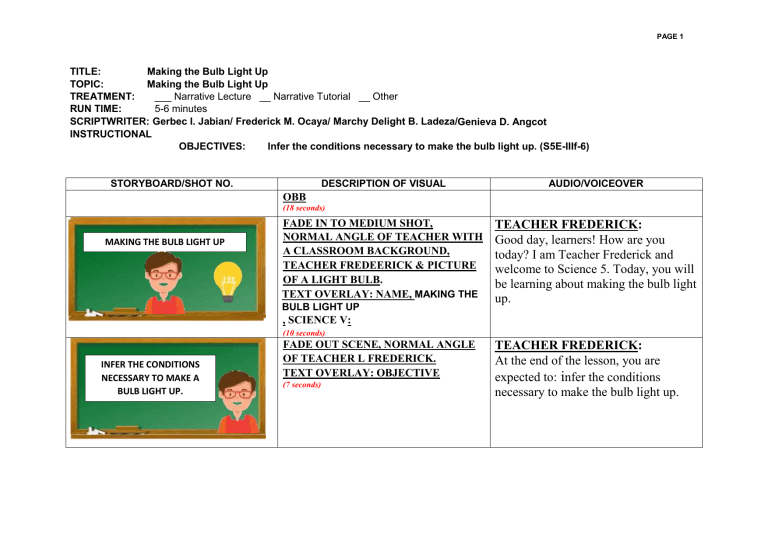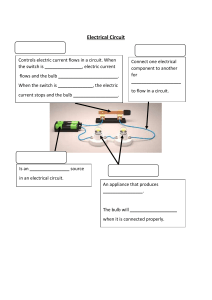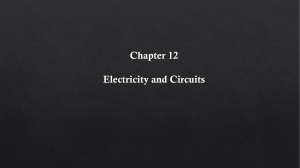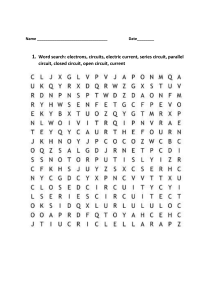
PAGE 1 TITLE: Making the Bulb Light Up TOPIC: Making the Bulb Light Up TREATMENT: ___ Narrative Lecture __ Narrative Tutorial __ Other RUN TIME: 5-6 minutes SCRIPTWRITER: Gerbec I. Jabian/ Frederick M. Ocaya/ Marchy Delight B. Ladeza/Genieva D. Angcot INSTRUCTIONAL OBJECTIVES: Infer the conditions necessary to make the bulb light up. (S5E-IIIf-6) STORYBOARD/SHOT NO. DESCRIPTION OF VISUAL AUDIO/VOICEOVER OBB (18 seconds) MAKING THE BULB LIGHT UP MAKING A BULB LIGHT FADE IN TO MEDIUM SHOT, NORMAL ANGLE OF TEACHER WITH A CLASSROOM BACKGROUND, TEACHER FREDEERICK & PICTURE OF A LIGHT BULB. TEXT OVERLAY: NAME, MAKING THE BULB LIGHT UP TEACHER FREDERICK: Good day, learners! How are you today? I am Teacher Frederick and welcome to Science 5. Today, you will be learning about making the bulb light up. , SCIENCE V: (10 seconds) INFER THE CONDITIONS NECESSARY TO MAKE A BULB LIGHT UP. FADE OUT SCENE, NORMAL ANGLE OF TEACHER L FREDERICK. TEXT OVERLAY: OBJECTIVE (7 seconds) TEACHER FREDERICK: At the end of the lesson, you are expected to: infer the conditions necessary to make the bulb light up. PAGE 2 STORYBOARD/SHOT NO. DESCRIPTION OF VISUAL FADE OUT SCENE, NORMAL ANGLE OF TEACHER FREDERICK. PICTURE ANIMATION POP OUT TEXT OVERLAY: WHAT IS ELECTRICITY What is Electricity? Electricity is a form of energy resulting from the flow of electric charges. (5 seconds) NEXT CLIP, PICTURE ANIMATION POP OUT: SIMPLE ELECTRIC CIRCUIT. . source (20 seconds) flow continuously load conductors AUDIO/VOICEOVER TEACHER FREDERICK: Before we start our lesson, let us know first What is Electricity? Electricity -Is a form of energy resulting from the flow of electric charges. Now, in order for electricity to be useful, it must flow continuously and follow a path. This complete path along which electricity flows is called an electric circuit. Likewise, when electrical current flows continuously in a complete path, it will make a bulb light up. PAGE 3 STORYBOARD/SHOT NO. FOUR PARTS OF ELECTRICT CIRCUIT DESCRIPTION OF VISUAL CLIP CHANGE, PICTURE AND TEXT OVERLAY: PARTS OF AN ELECTRIC CIRCUIT (12 seconds) switch AUDIO/VOICEOVER The electric circuit has four parts: the Source, the Conductors, the Load, and the Switch. Each part has a corresponding symbol and function that makes up an electric circuit. source load conductors ENERGY SOURCE NEXT CLIP, TEXT OVERLAY: SOURCE ANIMATION POP OUT: SOURCE SYMBOL, DESCRIPTION: FUNCTIONS AND EXAMPLES The first part of the electric circuit is the source. The ENERGY SOURCE is a source of electricity. It’s the power that is used to run the circuit. For example, it could be a generator, a dry cell battery, and a solar cell. (13 seconds) CONDUCTOR OR PATH NEXT CLIP, TEXT OVERLAY: SOURCE ANIMATION POP OUT: CONDUCTORS OR PATH SYMBOL, DESCRIPTION: FUNCTIONS AND EXAMPLES (11 seconds) Second part is a CONDUCTOR or PATH. It is a pathway of electricity from the source to the load. Examples of conductors are electric wires and electric cords. PAGE 4 STORYBOARD/SHOT NO. LOAD SWITCH DESCRIPTION OF VISUAL NEXT CLIP, TEXT OVERLAY: SOURCE Third is the LOAD. ANIMATION POP OUT: LOAD is an appliance or any device that uses LOAD SYMBOL, DESCRIPTION: electricity from the source. Example: light FUNTIONS AND EXAMPLES bulb, TV, or a radio. (10 seconds) NEXT CLIP, TEXT OVERLAY: SOURCE ANIMATION POP OUT: SWITCH SYMBOL, DESCRIPTION: FUNTIONS AND EXAMPLES (12 seconds) DIAGRAM OF ELECTRIC CIRCUIT AUDIO/VOICEOVER FADE IN TO MEDIUM SHOT OF TEACHER, NORMAL ANGLE, DIAGRAM OF AN ELECTRIC CIRCUIT POPS UP WHEN MENTIONED FIRST, (10 seconds) The last part of the electric circuit is called a SWITCH, it controls the flow of electricity and is used to open or close circuit by switching it “off or on”. Example: switches on the wall. TEACHER FREDERICK: Those are the four parts of the electric circuit. Here is a diagram of an electric circuit where all the parts are connected. PAGE 5 STORYBOARD/SHOT NO. DESCRIPTION OF VISUAL MAINTAIN MEDIUM SHOT, NORMAL ANGLE OF TEACHER FREDERICK (10 seconds) CLIP CHANGE, FADE IN, NORMAL ANGLE OF TEACHER FREDERICK DIFFERENT BACKGROUND, PICTURE OF AN OPEN AND CLOSE (20 seconds) AUDIO/VOICEOVER TEACHER FREDERICK: Now that we’ve learned the four parts of an electric circuit, the next thing we need to know are the CONDITIONS NECESSARY TO MAKE A BULB LIGHT UP. TEACHER FREDERICK: Electricity flows continuously only in a closed circuit as shown in Figure 2. This means that all parts of the circuit are properly connected to each other. PAGE 6 CLIP CHANGE, DIFFERENT BACKGROUND, FADE IN, NORMAL ANGLE OF TEACHER FREDERICK PICTURE OF AN OPEN AND CLOSE If the circuit is broken or open as shown in Figure 3, the electrical energy will stop flowing. Hence, the bulb will not light up. (20 seconds) NEXT CLIP, PICTURE ANIMATION POP OUT Illustration of wire properly connected to negative end of the battery and the other wire to the positive end of the battery. (10 seconds) TEACHER FREDERICK: One end of the wire must be properly connected to the negative (-) end of the battery and the other wire to the positive (+) end of the battery. It will make the bulb light up. . PAGE 7 STORYBOARD/SHOT NO. ELECTRIC CIRCUIT DESCRIPTION OF VISUAL NEXT CLIP, PICTURE ANIMATION POP OUT AUDIO/VOICEOVER ELECTRIC CIRCUIT TEACHER FREDERICK: Always remember that in order for electricity to be useful, it must flow continuously and follow a path. This complete path along which electricity flows is called an electric circuit. Likewise, when electrical current flows continuously in a complete path, it can make the bulb light up. FADE IN TO MEDIUM SHOT, NORMAL ANGLE OF TEACHER FREDERICK. TEACHER FREDERICK: I hope you are having a great day with me and you have learned something new. God bless everyone. Goodbye! Complete path (20 seconds) flow continuously (20 seconds) FADE OUT PAGE 8 CBB (10 seconds) -END-



